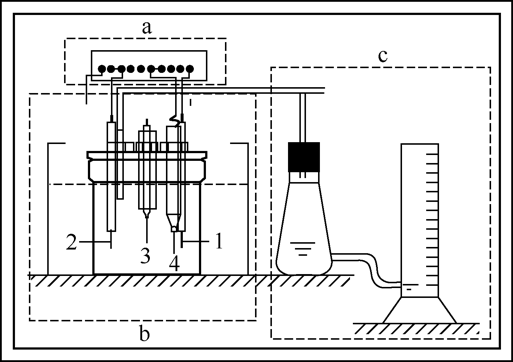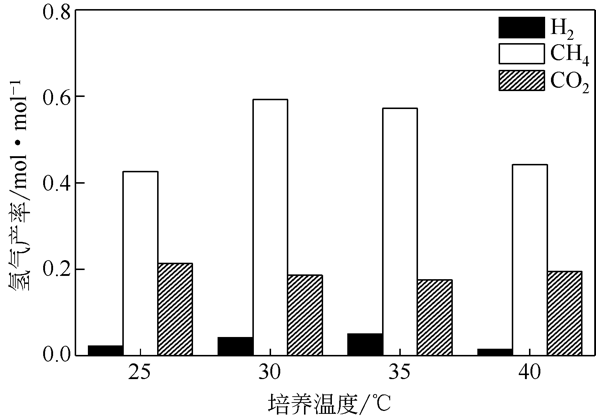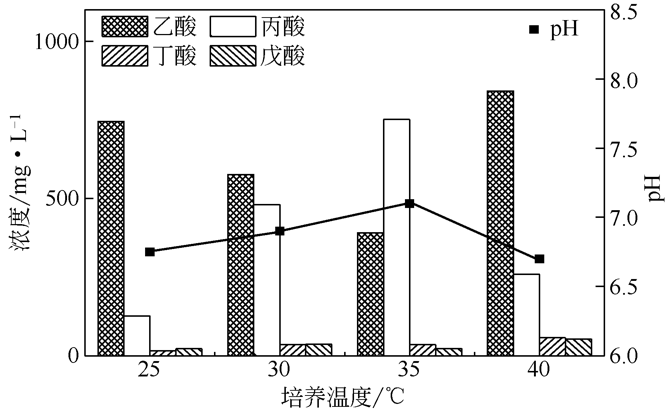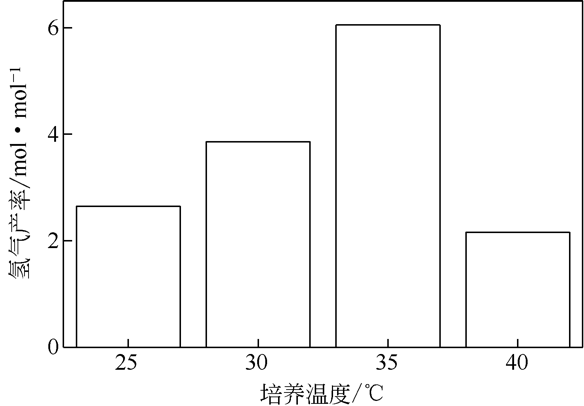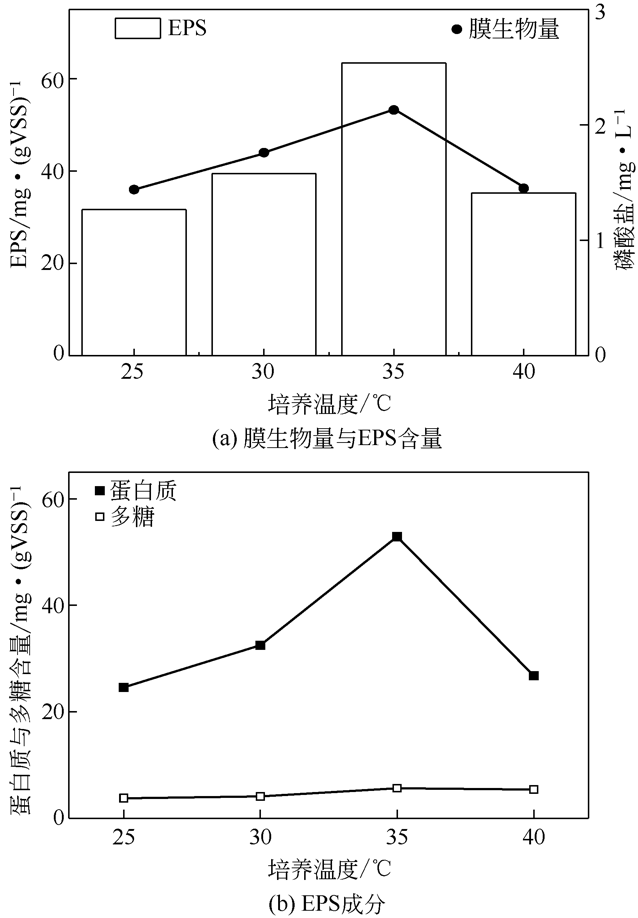Chemical Industry and Engineering Progress ›› 2019, Vol. 38 ›› Issue (08): 3809-3815.DOI: 10.16085/j.issn.1000-6613.2018-2358
• Biochemical and pharmaceutical engineering • Previous Articles Next Articles
Influence of temperature on MEC anode biofilm formation and extracellular polymers substances
Helin SUN( ),Qiongli SHAO,Jianchang LI(
),Qiongli SHAO,Jianchang LI( ),Jingzhu ZHENG,Kunde XU,Xiangang LONG
),Jingzhu ZHENG,Kunde XU,Xiangang LONG
- Solar Energy Research Institute, Yunnan Normal University, Kunming 650500, Yunnan, China
-
Received:2018-12-04Online:2019-08-05Published:2019-08-05 -
Contact:Jianchang LI
温度对MEC阳极膜形成及胞外聚合物的影响
- 云南师范大学太阳能研究所,云南 昆明 650500
-
通讯作者:李建昌 -
作者简介:孙和临(1994—),男,硕士研究生,研究方向为微生物电解池。E-mail:gent.ssun@foxmail.com 。 -
基金资助:国家自然科学基金(21463029)
CLC Number:
Cite this article
Helin SUN,Qiongli SHAO,Jianchang LI,Jingzhu ZHENG,Kunde XU,Xiangang LONG. Influence of temperature on MEC anode biofilm formation and extracellular polymers substances[J]. Chemical Industry and Engineering Progress, 2019, 38(08): 3809-3815.
孙和临,邵琼丽,李建昌,郑金柱,许坤德,龙宪钢. 温度对MEC阳极膜形成及胞外聚合物的影响[J]. 化工进展, 2019, 38(08): 3809-3815.
share this article
Add to citation manager EndNote|Ris|BibTeX
URL: https://hgjz.cip.com.cn/EN/10.16085/j.issn.1000-6613.2018-2358
| 特征吸收波数/cm-1 | 指定分子结构 | |||
|---|---|---|---|---|
| 25℃ | 30℃ | 35℃ | 40℃ | |
| 3445 | 3440 | 3440 | 3435 | O—H与—NH2伸缩振动 |
| 2923 | 2922 | 2920 | 2920 | C—H伸缩振动 |
| 2851 | 2851 | 2580 | 2851 | C—H伸缩振动 |
| 1640 | 1633 | 1640 | 1642 | —C O伸缩振动 (酰胺Ⅰ区) O伸缩振动 (酰胺Ⅰ区) |
| 1542 | 1542 | 1543 | 1542 | —NH平面弯曲—CN伸缩(酰胺Ⅱ区) |
| 1383 | 1384 | 1384 | 1384 | —CH3或O—H平面弯曲 |
| — | — | 1234 | — | P O核酸或磷酸化蛋白的磷酸二酯键伸缩振动 O核酸或磷酸化蛋白的磷酸二酯键伸缩振动 |
| 1035 | 1040 | 1044 | 1040 | C—O—P伸缩振动 |
| 特征吸收波数/cm-1 | 指定分子结构 | |||
|---|---|---|---|---|
| 25℃ | 30℃ | 35℃ | 40℃ | |
| 3445 | 3440 | 3440 | 3435 | O—H与—NH2伸缩振动 |
| 2923 | 2922 | 2920 | 2920 | C—H伸缩振动 |
| 2851 | 2851 | 2580 | 2851 | C—H伸缩振动 |
| 1640 | 1633 | 1640 | 1642 | —C O伸缩振动 (酰胺Ⅰ区) O伸缩振动 (酰胺Ⅰ区) |
| 1542 | 1542 | 1543 | 1542 | —NH平面弯曲—CN伸缩(酰胺Ⅱ区) |
| 1383 | 1384 | 1384 | 1384 | —CH3或O—H平面弯曲 |
| — | — | 1234 | — | P O核酸或磷酸化蛋白的磷酸二酯键伸缩振动 O核酸或磷酸化蛋白的磷酸二酯键伸缩振动 |
| 1035 | 1040 | 1044 | 1040 | C—O—P伸缩振动 |
| 1 | 王博, 高冠道, 李凤祥, 等 . 微生物电解池应用研究进展[J]. 化工进展, 2017, 36(3): 1084-1092. |
| WANG Bo , GAO Guandao , LI Fengxiang , et al . Advance in application of microbial electrolysis cells[J]. Chemical Industry and Engineering Progress, 2017, 36(3): 1084-1092. | |
| 2 | YANG N , HAFEZ H , NAKHLA G . Impact of volatile fatty acids on microbial electrolysis cell performance[J]. Bioresource Technology, 2015, 193(6): 449-455. |
| 3 | LIU H , RAMNARAYANAN R , LOGAN B E . Production of electricity during wastewater treatment using a single chamber microbial fuel cell[J]. Environmental Science & Technology, 2006, 38(7): 2281-2285. |
| 4 | YOU S , ZHAO Q , ZHANG J , et al . A graphite-granule membrane-less tubular air-cathode microbial fuel cell for power generation under continuously operational conditions[J]. Power Sources, 2007, 173(1): 172-177. |
| 5 | JADHAV G S , GHANGREKAR M M . Performance of microbial fuel cell subjected to variation in pH, temperature, external load and substrate concentration[J]. Bioresource Technology, 2009, 100(2): 717-723. |
| 6 | CATAL T , KAVANAGH P , O’FLAHERTY V , et al . Generation of electricity in microbial fuel cells at sub-ambient temperatures[J]. Journal of Power Sources, 2011, 196(5): 2676-2681. |
| 7 | WAGNER R C , CALL D F , LOGAN B E . Optimal set anode potentials vary in bioelectrochemical systems[J]. Environmental Science & Technology, 2010, 44(16): 6036-6041. |
| 8 | FINKELSTEIN D A , TENDER L M , ZEIKUS J G . Effect of electrode potential on electrode-reducing microbiota[J]. Environmental Science & Technology, 2006, 40(22): 6990-6995. |
| 9 | KYAZZE G , POPOV A , DINSDALE R , et al . Influence of catholyte pH and temperature on hydrogen production from acetate using a two chamber concentric tubular microbial electrolysis cell[J]. International Journal of Hydrogen Energy, 2010, 35(15): 7716-7722. |
| 10 | KIM J R , MIN B , LOGAN B E . Evaluation of procedures to acclimate a microbial fuel cell for electricity production[J]. Applied Microbiology and Biotechnology, 2005, 68(1): 23-30. |
| 11 | RITTMANN B E , MCCARTY P L . Environmental biotechnology: principles and applications[M]. Boston: McGraw-Hill, 2001. |
| 12 | 闫立龙, 刘玉, 任源 . 胞外聚合物对好氧颗粒污泥影响的研究进展[J]. 化工进展, 2013, 32(11): 2744-2748. |
| YAN Lilong , LIU Yu , REN Yuan . A review on the effects of extracellular polymeric substance to aerobic granular sludge[J]. Chemical Industry and Engineering Progress, 2013, 32(11): 2744-2748. | |
| 13 | NAM J Y, KIM H W , LIM K H . Electricity generation from MFCs using differently grown anode-attached bacteria[J]. Environmental Engineering Research, 2010, 15(2): 71-78. |
| 14 | VEREA L , SAVADOGO O , VERDE A , et al . Performance of a microbial electrolysis cell (MEC) for hydrogen production with a new process for the biofilm formation[J]. International Journal of Hydrogen Energy, 2014, 39(17): 8938-8946. |
| 15 | 陆佳, 刘永军, 刘喆, 等 . 有机负荷对污泥胞外聚合物分泌特性及颗粒形成的影响[J]. 化工进展, 2018, 37(4): 1616-1622. |
| LU Jia , LIU Yongjun , LIU Zhe , et al . Effects of organic loading on the secretory characteristics of EPS and particle formation[J]. Chemical Industry and Engineering Progress, 2018, 37(4): 1616-1622. | |
| 16 | 张兰河, 王佳平, 陈子成, 等 . Ca2+对序批式生物反应器活性污泥性能的影响[J]. 化工进展, 2018, 37(9): 3675-3681. |
| ZHANG Lanhe , WANG Jiaping , CHEN Zicheng , et al . Effect of Ca2+ on the properties of activated sludge in the SBR[J]. Chemical Industry and Engineering Progress, 2018, 37(9): 3675-3681. | |
| 17 | 王亚利, 刘永军, 刘喆, 等 . 聚合氯化铝投加时间对好氧颗粒污泥的形成和胞外聚合物的影响[J]. 化工进展, 2015, 34(1): 278-284. |
| WANG Yali , LIU Yongjun , LIU Zhe , et al . Influence of poly aluminium chloride dosing time on formation and EPS of aerobic granular sludge[J]. Chemical Industry and Engineering Progress, 2015, 34(1): 278-284. | |
| 18 | KATO S , HASHIMOTO K , WATANABE K . Methanogenesis facilitated by electric syntrophy via (semi) conductive iron-oxide minerals[J]. Environmental Microbiology, 2012, 14(7): 1646-1654. |
| 19 | 赵煜, 薄晓, 马彦, 等 . 不同温度下微生物燃料电池的运行特性[J]. 化工进展, 2014, 33(3): 629-650. |
| ZHAO Yu , BO Xiao , Yan MA , et al . Research on producing electricity characteristics of microbial fuel cell at different temperatures[J]. Chemical Industry and Engineering Progress, 2014, 33(3): 629-650. | |
| 20 | 詹亚力, 王琴, 张佩佩, 等 . 微生物燃料电池影响因素及作用机理探讨[J]. 高等学校化学学报, 2008, 29(1): 144-148. |
| ZHAN Yali , WANG Qin , ZHANG Peipei , et al . Investigation on influence factors and mechanism of microbial fuel cell[J]. Chemical Journal of Chinese Universities, 2008, 29(1): 144-148. | |
| 21 | MARSILI E , ROLLEFSON J B , BARON D B , et al . Microbial biofilm voltammetry: direct electrochemical characterization of catalytic electrode-attached biofilms[J]. Applied & Environmental Microbiology, 2008, 74(23): 7329-7337. |
| 22 | VU B, CHEN M , CRAWFORD R J , et al . Bacterial extracellular polysaccharides involved in biofilm formation[J]. Molecules, 2009, 14(7): 2535-2554. |
| 23 | ZHANG L , ZHU X , LI J , et al . Biofilm formation and electricity generation of a microbial fuel cell started up under different external resistances[J]. Journal of Power Sources, 2011, 196(15): 6029-6035. |
| 24 | REGUERA G , MCCARTHY K D , MEHTA T , et al . Extracellular electron transfer via microbial nanowires[J]. Nature, 2005, 435(7045): 1098-1101. |
| 25 | SUN X F , WANG S G , ZHANG X M , et al . Spectroscopic study of Zn2+ and Co2+ binding to extracellular polymeric substances (EPS) from aerobic granules[J]. Journal of Colloid and Interface Science, 2009, 335(1): 11-17. |
| 26 | XU C , ZHANG S , CHUANG C Y , et al . Chemical composition and relative hydrophobicity of microbial exopolymeric substances (EPS) isolated by anion exchange chromatography and their actinide-binding affinities[J]. Marine Chemistry, 2011, 126(1): 27-36. |
| 27 | MARUYAMA T , KATOH S , NAKAJIMA M , et al . FT-IR analysis of BSA fouled on ultrafiltration and microfiltration membranes[J]. Journal of Membrane Science, 2001, 192(1): 201-207. |
| 28 | OMOIKE A , CHOROVER J . Spectroscopic study of extracellular polymeric substances from bacillus subtilis: aqueous chemistry and adsorption effects[J]. Biomacromolecules, 2004, 5(4): 1219-1230. |
| 29 | COMTE S , GUIBAUD G , BAUDU M . Relations between extraction protocols for activated sludge extracellular polymeric substances (EPS) and EPS complexation properties. PartⅠ. Comparison of the efficiency of eight EPS extraction methods[J]. Enzyme and Microbial Technology, 2006, 38(1): 246-252. |
| [1] | XIE Luyao, CHEN Songzhe, WANG Laijun, ZHANG Ping. Platinum-based catalysts for SO2 depolarized electrolysis [J]. Chemical Industry and Engineering Progress, 2023, 42(S1): 299-309. |
| [2] | XU Maoyu, TAO Shuai, QI Cong, LIANG Lin. Start-up and temperature fluctuation of loop heat pipe with flat disk evaporator [J]. Chemical Industry and Engineering Progress, 2023, 42(9): 4531-4537. |
| [3] | LUO Cheng, FAN Xiaoyong, ZHU Yonghong, TIAN Feng, CUI Louwei, DU Chongpeng, WANG Feili, LI Dong, ZHENG Hua’an. CFD simulation of liquid distribution in different distributors in medium-low temperature coal tar hydrogenation reactor [J]. Chemical Industry and Engineering Progress, 2023, 42(9): 4538-4549. |
| [4] | GE Quanqian, XU Mai, LIANG Xian, WANG Fengwu. Research progress on the application of MOFs in photoelectrocatalysis [J]. Chemical Industry and Engineering Progress, 2023, 42(9): 4692-4705. |
| [5] | SHI Yu, ZHAO Yunchao, FAN Zhixuan, JIANG Dahua. Experimental study on the optimum phase change temperature of phase change roofs in hot summer and cold winter areas [J]. Chemical Industry and Engineering Progress, 2023, 42(9): 4828-4836. |
| [6] | CHEN Xiangyu, BIAN Chunlin, XIAO Benyi. Research progress on temperature phased anaerobic digestion technology [J]. Chemical Industry and Engineering Progress, 2023, 42(9): 4872-4881. |
| [7] | YANG Ying, HOU Haojie, HUANG Rui, CUI Yu, WANG Bing, LIU Jian, BAO Weiren, CHANG Liping, WANG Jiancheng, HAN Lina. Coal tar phenol-based carbon nanosphere prepared by Stöber method for adsorption of CO2 [J]. Chemical Industry and Engineering Progress, 2023, 42(9): 5011-5018. |
| [8] | ZHANG Yajuan, XU Hui, HU Bei, SHI Xingwei. Preparation of NiCoP/rGO/NF electrocatalyst by eletroless plating for efficient hydrogen evolution reaction [J]. Chemical Industry and Engineering Progress, 2023, 42(8): 4275-4282. |
| [9] | ZHAO Jian, ZHUO Zewen, DONG Hang, GAO Wenjian. A new method for observation of microstructure of waxy crude oil and its emulsion system [J]. Chemical Industry and Engineering Progress, 2023, 42(8): 4372-4384. |
| [10] | ZHANG Xuewei, HUANG Yaji, XU Yueyang, CHENG Haoqiang, ZHU Zhicheng, LI Jinlei, DING Xueyu, WANG Sheng, ZHANG Rongchu. Adsorption characteristics of SO3 from coal flue gas by alkaline adsorbent [J]. Chemical Industry and Engineering Progress, 2023, 42(7): 3855-3864. |
| [11] | WANG Yunqing, YANG Guorui, YAN Wei. Transition metal phosphide modification and its applications in electrochemical hydrogen evolution reaction [J]. Chemical Industry and Engineering Progress, 2023, 42(7): 3532-3549. |
| [12] | SUN Zhengnan, LI Hongjing, JING Guolin, ZHANG Funing, YAN Biao, LIU Xiaoyan. Application of EVA and its modified polymer in crude oil pour point depressant field [J]. Chemical Industry and Engineering Progress, 2023, 42(6): 2987-2998. |
| [13] | ZHANG Wei, QIN Chuan, XIE Kang, ZHOU Yunhe, DONG Mengyao, LI Jie, TANG Yunhao, MA Ying, SONG Jian. Application and performance enhancement challenges of H2-SCR modified platinum-based catalysts for low-temperature denitrification [J]. Chemical Industry and Engineering Progress, 2023, 42(6): 2954-2962. |
| [14] | XU Xian, CUI Louwei, LIU Jie, SHI Junhe, ZHU Yonghong, LIU Jiaojiao, LIU Tao, ZHENG Hua’an, LI Dong. Effect of raw material composition on the development of semicoke mesophase structure [J]. Chemical Industry and Engineering Progress, 2023, 42(5): 2343-2352. |
| [15] | FU Shurong, WANG Lina, WANG Dongwei, LIU Rui, ZHANG Xiaohui, MA Zhanwei. Oxygen evolution cocatalyst enhancing the photoanode performances for photoelectrochemical water splitting [J]. Chemical Industry and Engineering Progress, 2023, 42(5): 2353-2370. |
| Viewed | ||||||
|
Full text |
|
|||||
|
Abstract |
|
|||||
